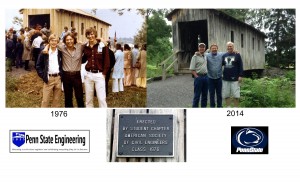Reminiscing in Happy Valley: Civil engineers reunite for the first time in three decades
This past summer, three former Penn State civil engineering classmates reunited when they came to State College to attend a wedding. One of them, Jim Foreman, contacted the college’s alumni and marketing/communications offices to tell their story.
“Before the wedding, Bob (Lee), Jim (Moore) and I met at Spring Creek Park (near Houserville) to see if the covered bridge project we completed in 1976 was still standing. As you can see from the photo, it was and the three of us were able to relive that time working together.”
 Jim Foreman, Bob Lee, and Jim Moore (L-R) near the bridge at Spring Creek Park
Jim Foreman, Bob Lee, and Jim Moore (L-R) near the bridge at Spring Creek Park
“The bridge was built to provide pedestrian access over Spring Creek as part of a public park development. The Penn State student chapter of the American Society of Civil Engineers (ASCE) sponsored and completed the work. Our adviser was Ralph Mozingo. The three of us were ASCE members and performed the surveying, layout and project management/documentation (photo/movie/time lapse). We also participated in and studied other aspects of the construction in partial fulfillment of the requirements for Chi Epsilon for Dr. Willenbrock’s CE 432 Construction Management course.
We have kept in touch since we all graduated in 1976, but this is the first time we all had a chance to be together in more than 30 years. We still acted and treated each other as good friends always do!”
James E. Foreman III, P.E. retired from Champion Aerospace as manager of manufacturing services. He resides in Spring, Texas.
Robert L. Lee is division administrator at the South Carolina Federal Highway Administration. He lives in Columbia, South Carolina. His wife, Gloria, is also a 1976 civil engineering graduate.
James P. Moore, P.E., CCM is chief, construction management at the U.S. Army Corps of Engineers headquarters. He resides in Washington, D.C.
Read More





Follow Us!